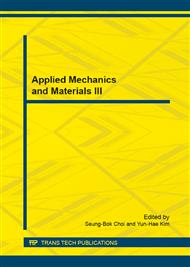[1]
Molyneux KR, Yu LM, Clarke M, et al. International subarachnoid aneurysm trial (ISAT) of neurosurgical clipping versus endovascular coiling in 2143 patients with ruptured intracranial aneurysms: a randomised comparison of effects on survival, dependency, seizures, rebleeding, subgroups, and aneurysm occlusion. Lancet, (2005).
DOI: 10.1016/s0140-6736(05)67214-5
Google Scholar
[2]
Burleson AC. Identification of quantifiable hemodynamic factors in the assessment of cerebral aneurysm behavior. On behalf of the subcommittee on Biorheology of the Scientific and Standardization Committee of the ISTH. Throm Haemost, (1996).
DOI: 10.1055/s-0038-1650533
Google Scholar
[3]
Valencia A, Solis F. Blood flow dynamics and arterial wall interaction in a saccular aneurysm model of the basilar artery. Computers and Structures, (2006), 84: 1326-1337.
DOI: 10.1016/j.compstruc.2006.03.008
Google Scholar
[4]
Shojima M, Oshima M, Takagi K, et al. Role of the bloodstream impacting force and the local pressure elevation in the rupture of cerebral aneurysms. Stroke, (2005), 36: 1933-(1938).
DOI: 10.1161/01.str.0000177877.88925.06
Google Scholar
[5]
Choi IS, David C. Giant intracranial aneurysms: development, clinical presentation and treatment. European Journal of Radiology, (2003), 46: 178-194.
DOI: 10.1016/s0720-048x(03)00090-1
Google Scholar
[6]
Jingliang Dong, Kelvin K. L, Hemodynamic analysis of patient-specific carotid bifurcation: A CFD model of downstream peripheral vascular impedance, INTERNATIONAL JOURNAL FOR NUMERICAL METHODS IN BIOMEDICAL ENGINEERING, (2012), 10. 1002/cnm. 2529.
DOI: 10.1002/cnm.2529
Google Scholar
[7]
Molony, D.S., Callanan,A., Morris L.G., Doyle B.J., Walsh M.T., McGloughlin T.M., Geometrical enhancements for abdominal aortic stentgrafts. Journal of Endovascular Therapy, (2008), 15, 518–529.
DOI: 10.1583/08-2388.1
Google Scholar
[8]
Li, Z., Kleinstreuer, C., Fluid-structure interaction effects on sac-blood pressure and wall stress in a stented abdominal aortic aneurysm. Journal of Biomechanical Engineering 127, (2005), 662–671.
DOI: 10.1115/1.1934040
Google Scholar
[9]
Di Martino ES, Guadagni G, Fumero A, Ballerini G, Spirito R, Biglioli P, Redaelli A, Fluid-structure interaction within realistic three-dimensional models of the aneurysmatic aorta as a guidance to assess the risk of rupture of the aneurysm, Med Eng Phys, (2001).
DOI: 10.1016/s1350-4533(01)00093-5
Google Scholar
[10]
Xiaohong Wang, XiaoyangLi, Fluid-structure interaction based study on the physiological factors affecting the behaviors of stented and non-stented thoracic aortic aneurysms, Journal of Biomechanics, (2011), 2177–2184.
DOI: 10.1016/j.jbiomech.2011.06.020
Google Scholar


